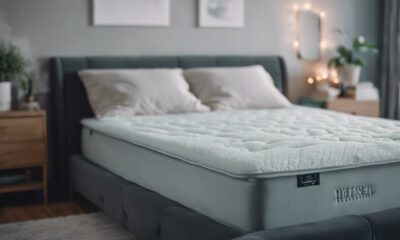Comforter
Can You Wash a Down Comforter With Vinegar
Wash your down comforter with vinegar to discover a natural and effective way to maintain freshness and prolong its lifespan.
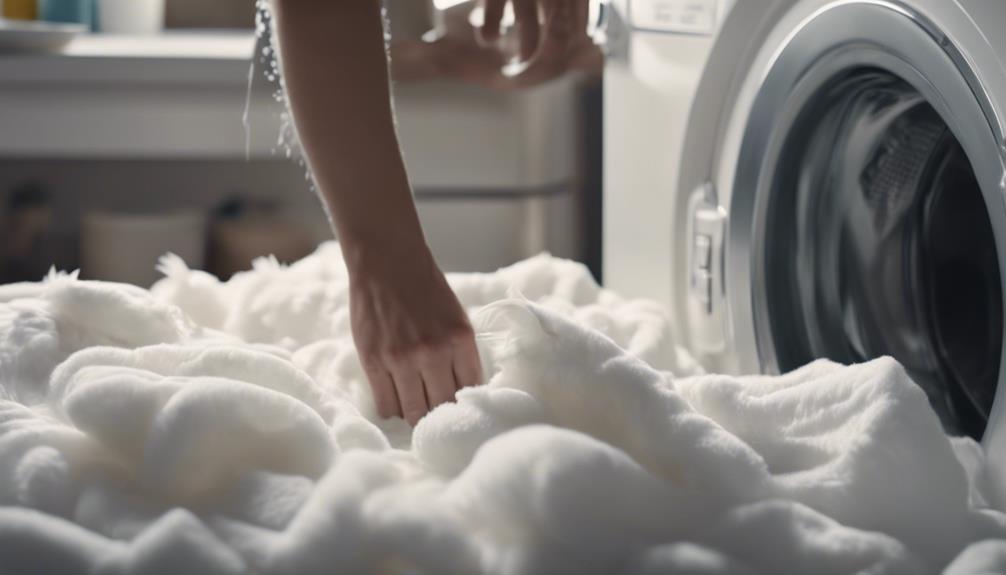
When cleaning a down comforter, the use of vinegar is essential. Vinegar serves as a natural disinfectant, helps prevent mold growth, and effectively eliminates odors. It also aids in maintaining freshness and extending the comforter’s lifespan. To clean with vinegar, mix it with water, use a mild detergent, and select a delicate wash cycle. Furthermore, white vinegar is excellent for eliminating odors and acting as a fabric softener. To enhance fluffiness, either air dry or tumble dry on low heat with tennis balls. By following these steps, you can ensure proper care and cleanliness for your down comforter.
Key Takeaways
- Vinegar disinfects and prevents mold in down comforters.
- Use white vinegar to eliminate odors and maintain freshness.
- Incorporate vinegar in washing cycles for effective cleaning.
- Vinegar acts as a natural deodorizer and fabric softener.
- Vinegar helps preserve down fluffiness and inhibits mold growth.
Benefits of Washing Down Comforter With Vinegar

Washing your down comforter with vinegar provides numerous benefits in effectively removing odors and bacteria while maintaining its freshness and loftiness. Vinegar, known for its natural disinfectant properties, is gentle yet powerful when it comes to cleaning down comforters. When you wash your comforter with vinegar, it not only helps eliminate any unwanted smells but also acts as a deterrent to bacteria that may have accumulated over time. The acidity of vinegar aids in breaking down oils and dirt that can get trapped in the down material, ensuring a thorough cleanse.
Moreover, using vinegar as a cleaning agent isn't only cost-effective but also eco-friendly, making it a great choice for those looking to reduce their environmental impact. By incorporating vinegar into your wash cycle, you can rest assured that your down comforter won't only be clean but also retain its fluffy loftiness, providing you with a cozy and sanitary sleeping environment.
Proper Care Instructions for Down Comforters
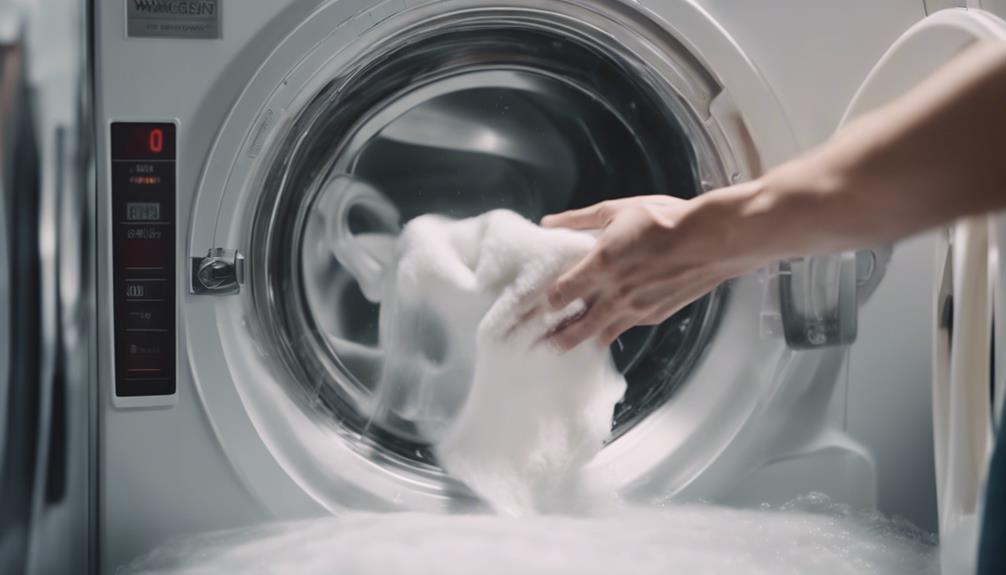
When caring for down comforters, it is crucial to follow specific guidelines to maintain their quality and longevity. Proper care instructions for down comforters include using vinegar in the wash cycle to help remove odors and bacteria, acting as a natural fabric softener that preserves the fluffiness of the down. Vinegar is a mild and effective cleaning agent that safeguards the delicate feathers of the comforter, extending its lifespan. Mixing vinegar with water before adding it to the wash cycle can enhance the cleaning process while being gentle on the down comforter.
| Care Instruction | Description |
|---|---|
| Use Vinegar | Helps remove odors and bacteria from the down comforter, acting as a natural fabric softener. |
| Gentle Detergent | Use a mild detergent suitable for delicate fabrics to safeguard the down comforter remains intact. |
| Fluffiness Maintenance | Vinegar helps maintain the fluffiness of the down, keeping the comforter soft and cozy. |
| Cleaning Technique | Mix vinegar with water before adding it to the wash cycle for effective and gentle cleaning. |
| Wash Cycle | Opt for a gentle wash cycle to protect the delicate feathers of the down comforter during cleaning. |
Steps to Wash a Down Comforter With Vinegar

Let's explore the essential steps involved in washing a down comforter with vinegar to maximize its benefits.
We'll cover how to properly incorporate vinegar into the washing process and guarantee a thorough cleaning of the comforter.
Vinegar Benefits for Comforter
To effectively utilize the benefits of vinegar for washing a down comforter, consider adding it to the rinse cycle for optimal results. Vinegar plays an essential role in cleaning the down comforter by eliminating odors and bacteria that may have accumulated over time.
Its natural fabric softening properties help maintain the fluffiness and softness of the down after washing, ensuring a cozy and comfortable feel. Additionally, vinegar aids in breaking down detergent residue, guaranteeing a thorough and clean wash for the comforter. It can also assist in removing stubborn stains and spots from the fabric during the washing process.
Washing Process Using Vinegar
For effectively washing a down comforter with vinegar, begin by preparing the washing machine and adding the appropriate amount of detergent.
Place the down comforter in the machine and pour half a cup of vinegar into the detergent dispenser. Set the machine to a gentle cycle with cold water to avoid damaging the delicate down filling.
The vinegar will act as a natural cleaning agent, effectively removing odors and bacteria from the comforter. Once the cycle is complete, make sure that the comforter is thoroughly rinsed to remove any residual vinegar.
Importance of Using White Vinegar in Cleaning

Using white vinegar in cleaning is crucial for maintaining the integrity and freshness of a down comforter. White vinegar serves as a powerful cleaning agent that effectively eliminates odors from the comforter, guaranteeing a clean and pleasant sleeping experience.
Additionally, when used during the washing process, white vinegar acts as a fabric softener, helping to preserve the fluffiness of the down feathers. Its gentle cleaning properties break down oils and residues without causing any damage to the delicate down material.
Opting for white vinegar as a natural alternative over harsh chemicals not only guarantees a thorough cleaning but also contributes to eco-friendly practices. By incorporating white vinegar into the cleaning routine, you can effectively remove mildew smells and other unwanted odors, leaving your down comforter smelling fresh and clean.
Make the most of this versatile ingredient to maintain the quality and longevity of your favorite bedding essential.
Tips for Removing Moldy Smell in Comforters

When dealing with a moldy smell in comforters, it's important to utilize effective techniques for odor removal.
Preventing mold growth is vital to make sure the comforter stays fresh for longer periods.
Natural deodorizing methods like using vinegar can be a valuable tool in combating musty odors.
Moldy Smell Removal Techniques
To effectively remove moldy smells from comforters, consider using white vinegar during the wash cycle. White vinegar is known for its effectiveness in eliminating moldy odors from down comforters. Adding vinegar to the wash cycle can help break down the musty smell, leaving your comforter fresh and clean.
Additionally, exposing the comforter to sunlight after washing can further aid in removing moldy smells. It's important to make sure the comforter is fully dried to prevent any lingering odors. If the moldy smell persists, professional dry cleaning services can also be a reliable option for thoroughly removing the unpleasant odor from your comforter.
Regular maintenance and proper drying techniques are key to keeping your comforter smelling fresh and clean.
Preventing Mold Growth
Implementing regular cleaning routines is essential for preventing mold growth in comforters and effectively removing any lingering moldy smells.
To prevent mold from developing on your down comforter, consider using vinegar during the washing cycle. Mixing warm water with vinegar can act as a natural disinfectant, killing mold spores and eliminating musty odors.
Adding white vinegar to your wash cycle not only refreshes the comforter but also helps in preventing mold growth.
After washing with vinegar, exposing the comforter to sunlight can further aid in removing moldy smells and disinfecting the fabric.
Natural Deodorizing Methods
Using white vinegar as a natural deodorizer is an effective method for eliminating moldy smells from a down comforter. Adding white vinegar during the wash cycle can help remove odors effectively. Sunlight exposure aids in reducing moldy smells in a comforter treated with vinegar. Harsh detergents like bleach should be avoided when trying to eliminate odors from a comforter. Line drying and spinning the comforter after washing with vinegar can assist in eradicating moldy smells.
| Effective Methods for Removing Moldy Smells |
|---|
| 1. Use white vinegar during wash cycle |
| 2. Sunlight exposure after treatment |
| 3. Avoid harsh detergents like bleach |
Drying Techniques for Down Comforters

After washing a down comforter with vinegar, gently shake it out before proceeding with the drying process. It's crucial to dry the comforter properly to maintain its fluffiness and guarantee it's completely dry to prevent mold growth.
Here are some effective drying techniques for down comforters:
- Air Dry: Hang the comforter outside on a clothesline or lay it flat on a clean, dry surface. Make sure the area is well-ventilated to aid in the drying process.
- Low Heat Tumble Dry: If using a dryer, select the lowest heat setting to prevent damage to the down filling. Add a few clean tennis balls to the dryer to help fluff up the comforter.
- Fluff Periodically: During the drying process, pause occasionally to fluff the comforter by hand or give it a gentle shake to redistribute the down evenly.
Preventing Mold Growth in Down Comforters

To maintain the freshness of a down comforter and prevent mold growth, incorporating vinegar into the washing process serves as a natural disinfectant and mold deterrent. White vinegar, known for its mold-killing properties, is effective in eliminating mildew odors from down comforters. Adding vinegar to the washing machine during the cleaning cycle can help prevent mold and mildew buildup, keeping the comforter fresh and mold-free. Sunlight exposure post-wash can further inhibit mold growth in down comforters, as sunlight is a natural mold deterrent.
| Benefits of Using Vinegar in Washing Down Comforters | |
|---|---|
| Acts as a natural disinfectant | Helps prevent mold growth |
| Eliminates mildew odors | Inhibits mold and mildew buildup |
| Enhances freshness of comforter | Natural mold deterrent |
Vinegar as a Natural Deodorizing Solution
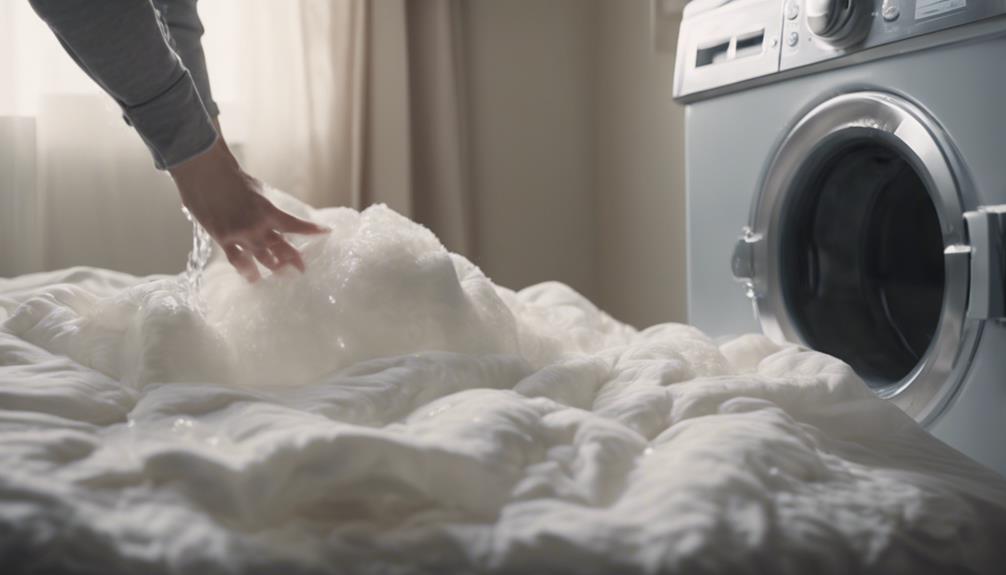
In our experience, incorporating white vinegar into the washing cycle effectively neutralizes odors in down comforters, providing a natural deodorizing solution. White vinegar is a versatile ingredient that helps eliminate musty smells and refresh the comforter without the use of harsh chemicals.
Here are some key points about using vinegar for deodorizing down comforters:
- Vinegar acts as a natural deodorizer, breaking down odor-causing bacteria in the fabric of the comforter.
- Adding vinegar to the wash cycle helps remove lingering odors, leaving the down comforter smelling fresh and clean.
- White vinegar is a safe and eco-friendly alternative to chemical deodorizers, making it a great choice for those looking to avoid harsh substances in their bedding.
Maintaining Down Comforter Quality

Maintaining the quality of a down comforter involves regular care and attention to guarantee longevity and peak performance. Washing your down comforter with vinegar not only helps eliminate odors and bacteria but also aids in preserving its fluffiness. Vinegar, being a natural cleaning agent, is gentle on the delicate down feathers, making it an ideal choice for cleaning.
By adding vinegar to the wash cycle, you can effectively remove mildew and musty smells that may have accumulated over time. This process not only refreshes your comforter but also ensures that it remains clean and free from harmful bacteria. Additionally, using vinegar is a cost-effective and environmentally friendly alternative to harsh chemicals, safeguarding the quality of your down comforter for years to come.
Frequently Asked Questions
How Do You Wash a Down Comforter Without Ruining It?
When washing a down comforter, it's crucial to protect its fluffiness and integrity. Start by checking the care label for specific instructions.
Use a gentle detergent in a large-capacity machine on a delicate cycle. Adding a couple of tennis balls can help maintain the fluff. Guarantee thorough rinsing to remove all soap residue.
Air dry or use a large dryer with low heat and periodically fluff the comforter to maintain its loft.
How to Wash White Comforter With Vinegar?
We can wash a white comforter with vinegar to help remove odors and bacteria while maintaining its fluffiness. Adding vinegar to the wash cycle acts as a natural fabric softener, preserving the comforter's quality.
White vinegar is gentle and effective, aiding in the removal of mildew smells and musty odors. This cost-effective and eco-friendly method is a great way to keep your comforter fresh and clean.
How Do I Get My Down Comforter White Again?
To get a down comforter white again, start by pretreating any stains with a mixture of vinegar and water. Then, wash the comforter in a large capacity machine with a gentle detergent and add a cup of vinegar during the rinse cycle. This will help whiten the fabric and remove any discoloration.
How Do You Keep a Down Comforter Fluffy After Washing?
To maintain a down comforter fluffy after washing, make sure to provide proper care. Use a gentle cycle with mild detergent and add vinegar to the rinse cycle.
Vinegar helps remove residue, acts as a fabric softener, and restores pH balance. It also acts as a deodorizer.
Following these steps will preserve the fluffiness of your down comforter, keeping it fresh and cozy for a long time.
Is Washing an Alternative Down Comforter the Same as Washing a Down Comforter with Vinegar?
Washing an alternative down comforter is different from washing a down comforter with vinegar. While vinegar can help fluff up and deodorize a down comforter, an alternative down comforter may require specific cleaning instructions to maintain its quality and lifespan. Always follow the manufacturer’s recommendations for best results.
Conclusion
To sum up, washing a down comforter with vinegar can be a beneficial and natural way to keep it clean and fresh. By following proper care instructions and using white vinegar, you can effectively remove dirt, stains, and odors from your comforter.
Remember, prevention is key to maintaining the quality of your comforter. As the saying goes, 'An ounce of prevention is worth a pound of cure.' So, take care of your down comforter with vinegar for lasting comfort and coziness.
Comforter
Can I Use a Down Comforter as a Mattress Topper
Optimize your sleep comfort with a down comforter as a mattress topper, offering luxurious softness and enhanced insulation – find out more!
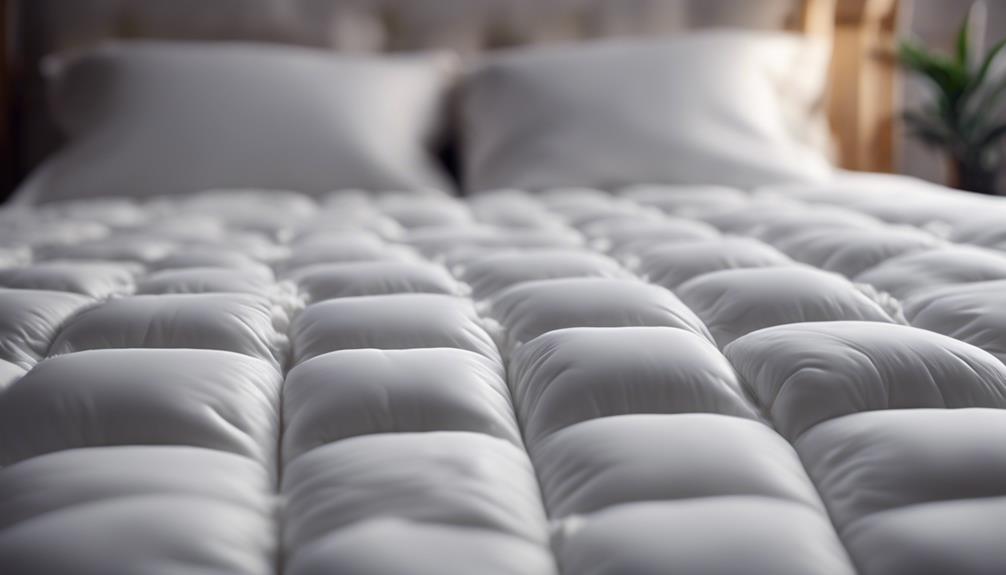
Using a down comforter as a mattress topper can improve the comfort and insulation of your bed. Placing it directly on top of the mattress underneath the fitted sheet allows it to conform to your body shape and provide a comfortable surface to sleep on. Before using, consider the thickness, fill power, and baffle box construction for the desired level of support. Regular cleaning and maintenance can help keep the down comforter feeling plush. Adding a down comforter to your bedding can add luxury and softness to your sleep, using white duck down for insulation. Its lightweight quality makes it easy to handle on the mattress. Learn more about the advantages and proper care to enhance your sleep experience.
Key Takeaways
- Down comforters can be used as mattress toppers for added comfort and warmth.
- Ensure the comforter fits the mattress size to provide effective coverage.
- Regularly rotate and fluff the comforter to maintain its plush feel.
- Consider using a cotton cover or duvet for extra protection.
- Enjoy the luxury and coziness of a down comforter as a versatile mattress topper.
Benefits of Using a Down Comforter
Using a down comforter as a mattress topper can greatly enhance the overall comfort and warmth of your bed. The feather-filled topper adds an extra layer of softness and coziness to your mattress, making for a more comfortable sleep experience.
The down filling, whether from geese or ducks, creates a plush feel that can help maintain body temperature while providing insulation during the night. This means you can stay warm and snug without feeling overheated.
By placing a down comforter on top of your mattress, you transform your bed into a haven of relaxation, perfect for unwinding after a long day. The topper's versatility allows for easy placement and removal, making it a convenient choice for those seeking a quick way to upgrade their sleep environment.
How to Properly Place a Down Comforter

To properly position a down comforter on your mattress for the best comfort and support, start by making sure it lies directly on top of the mattress under the fitted sheet. This positioning allows the down comforter, filled with luxurious white goose down, to adjust to your body contours, providing a cozy and supportive sleep surface. High-quality materials, such as Hungarian white goose down, offer extraordinary comfort, making your bed a sumptuous sanctuary for a restful night's sleep.
Proper placement of the down comforter is essential for maximizing its benefits. Regularly rotating the comforter and snapping it like a flat sheet can help redistribute the down evenly, maintaining its loft over time. By following these simple steps, you can guarantee that your down comforter remains plush and supportive, offering you a luxurious sleeping experience every night.
Factors to Consider Before Using

When contemplating using a down comforter as a mattress topper, evaluating its thickness and weight is vital to guarantee it offers the desired cushioning and support. The fill power of the comforter affects its fluffiness and insulating ability, so choose a fill power that suits your needs. Check if the comforter has baffle box construction to keep the down evenly distributed and prevent it from shifting. A cotton cover can help protect your mattress and provide a soft surface for sleeping. Make sure the comforter is the right size for your mattress to cover it effectively and stay securely in place.
Using a down comforter as a mattress topper can add extra warmth, which is beneficial in colder climates. However, it's important to take these factors into account before making the switch to ensure excellent comfort and functionality. By evaluating these elements, you can make an informed decision about using a down comforter as a mattress topper.
Cleaning and Maintenance Tips
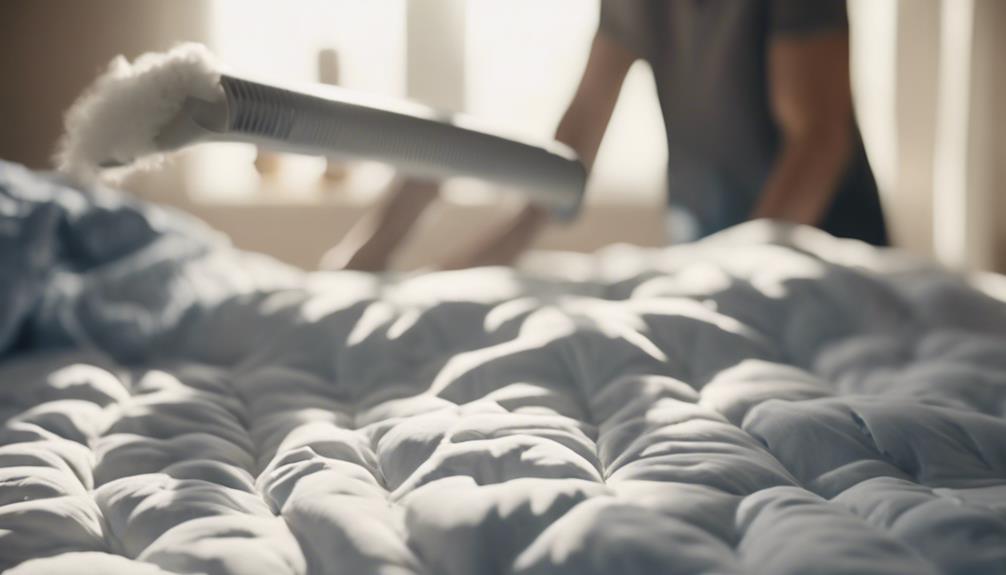
Regularly spot cleaning stains on your white goose down comforter mattress topper is vital to prevent them from setting and maintain its pristine condition. Using a feather bed protector can shield your down comforter from spills, dust, and allergens, extending its lifespan.
Remember to rotate your down comforter mattress topper periodically to guarantee even wear and prevent flat spots. Additionally, air out your down comforter mattress topper regularly to maintain freshness and fluffiness. Consider adding a duvet cover for added protection and easy cleaning.
Enhancing Comfort With a Down Comforter

Enhancing comfort with a down comforter as a mattress topper elevates the overall sleeping experience by providing an added layer of luxury and softness. White duck down, known for its exceptional insulating properties, creates a feather bed effect that's soft yet supportive.
When used as a mattress topper, a down comforter enhances the coziness of your bed, offering an inviting retreat at the end of a long day. The lightweight nature of down comforters makes them easy to manage on your mattress, ensuring a hassle-free experience.
Additionally, many down comforters are OEKO-TEX® certified, guaranteeing that they're free from harmful substances. This certification provides peace of mind regarding the quality and safety of the product you're using.
Frequently Asked Questions
Is Down Good for a Mattress Topper?
Down is excellent for a mattress topper due to its insulation and lightweight, fluffy nature. It offers a plush cushioning layer, enhancing your sleep experience with a luxurious feel.
Down's breathability helps regulate temperature for a comfortable rest. Overall, down is a cozy and comfortable choice that can elevate your mattress comfort level.
What Can I Use Instead of a Mattress Topper?
Instead of a mattress topper, we can explore alternatives like mattress pads, memory foam toppers, or even mattress protectors for added comfort. These options cater to various needs, such as extra cushioning, temperature regulation, or protection against allergens.
When choosing the best option to enhance our sleep quality and overall well-being, we must take into account our individual preferences and requirements.
Can I Use a Feather Duvet as a Mattress Topper?
Yes, a feather duvet can be used as a mattress topper. While it may not offer as much support as a traditional mattress topper, it can provide additional softness and comfort to your bed.
Feather duvets are known for their fluffiness and insulation properties, making your sleep experience cozier. Keep in mind that this makeshift solution may be temporary.
Using a feather duvet as a mattress topper can enhance your overall sleeping experience.
Is a Down Alternative Mattress Topper Hot?
Down alternative mattress toppers, like traditional down, regulate temperature well, making them a cooler option. They're designed with synthetic materials for breathability and cooling properties.
These toppers are typically hypoallergenic and suitable for allergy-prone individuals. Providing a balance of softness, support, and temperature control, they're an excellent choice for those seeking a comfortable night's sleep.
Is It Safe to Use Oxiclean on a Down Comforter That Can Also Be Used as a Mattress Topper?
Yes, it is safe to consider using Oxiclean on comforter or mattress topper made of down material. Oxiclean is a gentle yet effective cleaner that can remove stains and odors without damaging delicate fabrics like down. Just follow the label instructions and spot test first to ensure compatibility.
Conclusion
To sum up, utilizing a down comforter as a mattress topper can offer additional comfort and warmth to enhance your sleep experience.
Were you aware that research has indicated that sleeping with a down comforter can aid in improving the quality of sleep by regulating body temperature?
Therefore, if you're seeking a snug and indulgent solution to upgrade your mattress, consider utilizing a down comforter as a mattress topper for a more restful night's sleep.
Mason – Your Product Expert Mason is your go-to product expert, carefully selecting each item in our collection to ensure it meets your comfort, functionality, and style needs. With his attention to detail and commitment to quality, he ensures that every product we offer enhances your home experience.
Comforter
Can Comforters Get Bed Bugs
Fend off potential bed bug infestations by learning how comforters can harbor these pests, leading to effective prevention strategies.

Yes, comforters can contain bed bugs in their fabric, seams, and folds. These small insects survive on human blood and are most effectively eradicated by using high heat treatment in the dryer. Temperatures exceeding 120°F for 30 minutes kill bed bug eggs, nymphs, and adults efficiently. It is vital to regularly check for indicators like bloodstains and eggshells. Washing in hot water and drying at high heat can aid in getting rid of bed bugs. Keeping clean comforters sealed in plastic bags can prevent re-infestation. To ensure a bed bug-free space, consider investing in protective encasements made of bed bug-resistant materials. Protect yourself from infestations successfully.
Key Takeaways
- Bed bugs infest comforters in seams, folds, and fabric.
- Washing in hot water and high heat drying kills bed bugs.
- Sealing clean comforters in plastic bags prevents re-infestation.
- Regularly inspect for signs like bloodstains and small insects.
- Use protective encasements to create a bed bug barrier.
Understanding Bed Bugs in Comforters

When it comes to understanding bed bugs in comforters, it's crucial to recognize that these pests can easily infest and hide within the fabric, seams, and folds of the bedding. Bed bugs are tiny insects that feed on human blood and are skilled at finding cozy spots to nest, making comforters an ideal environment for them to lay eggs and thrive.
To combat bed bugs in comforters, utilizing high heat treatment in the dryer is a highly effective method to kill bed bug eggs, nymphs, and adults. By subjecting the comforter to temperatures above 120°F for at least 30 minutes, you can guarantee that the entire infestation is eradicated. High heat is a natural and chemical-free approach that's safe for most comforter materials.
It's important to remember that sealing clean comforters in durable plastic bags can also provide protection against bed bug infestations, preventing these pests from infiltrating your bedding and causing further issues.
Signs of Bed Bug Infestation

To detect a bed bug infestation in your comforter, carefully inspect for small, flat insects, droppings, bloodstains, red or brown stains, ivory-colored eggshells, live bed bugs, or dark brown fecal spots.
Look closely at the seams and folds of the comforter where bed bugs like to hide. If you notice tiny insects resembling apple seeds, dark spots or smears that could be bed bug feces, or red and brown stains that might be blood from crushed bugs, these could all be signs of a bed bug infestation.
Additionally, ivory-colored eggshells or live bed bugs near areas where you sleep are strong indicators of a problem. Pay attention to any itchy red skin or bite marks you might've after using the comforter, as these could also signal the presence of bed bugs.
Regularly checking for these signs can help you catch a bed bug infestation early and take appropriate action to address the issue promptly.
Prevention Tips for Comforters
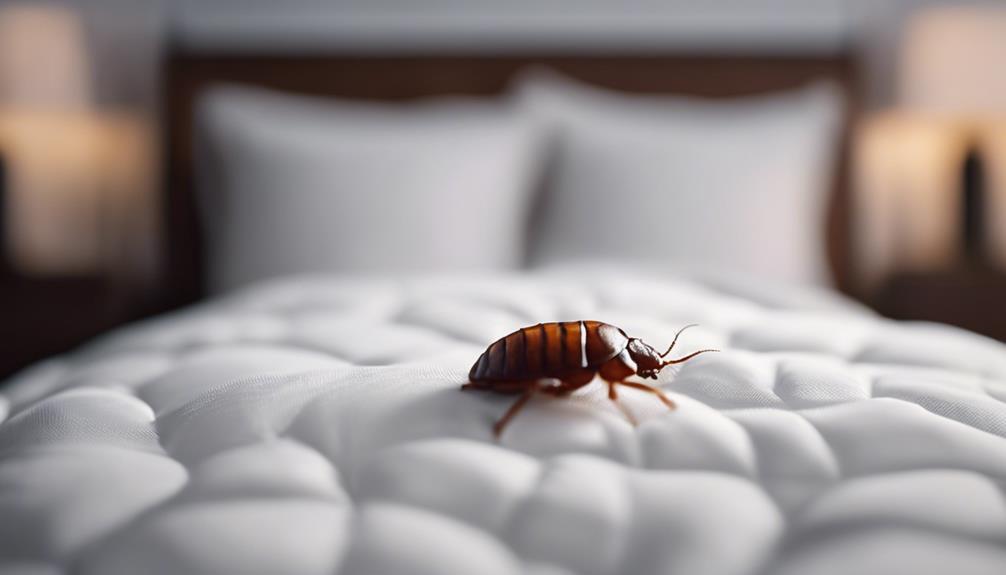
Wondering how to keep your comforter free from bed bugs? To prevent a bed bug infestation in your comforter, there are several proactive steps you can take.
First, regularly inspect your comforter for any signs of bed bugs, such as small reddish-brown stains or tiny dark spots that could indicate their presence. Washing your comforter in hot water and drying it on high heat can help eliminate any potential bed bugs and their eggs. Additionally, sealing your clean comforter in a plastic bag after washing can help reduce the risk of re-infestation.
It's also essential to keep your sleeping area clean and clutter-free, as bed bugs thrive in messy environments. By regularly cleaning your bedding, vacuuming your mattress and bed frame, and minimizing hiding spots for bed bugs, you can significantly lower the likelihood of an infestation in your comforter.
Washing and Treating Infested Comforters

If comforters become infested with bed bugs, the most effective way to eliminate them is by washing the comforter in hot water and drying it on high heat. Heat is bed bugs' worst enemy, as it kills them at all stages of life – eggs, nymphs, and adults. Here is a simple guide to help you effectively wash and treat an infested comforter:
| Steps to Wash and Treat Infested Comforters |
|---|
| 1. Wash the comforter in hot water |
| 2. Dry the comforter on high heat |
| 3. Seal the clean comforter in a durable plastic bag to prevent re-infestation |
When dealing with bed bugs, it's important to remember that washing and drying alone may not be enough. Make sure to also inspect your bed bug mattress and surrounding areas for any signs of infestation. If the problem persists, seeking professional help is the best course of action to ensure thorough removal and treatment.
Using Protective Encasements for Comforters

When seeking additional protection against bed bug infestations in comforters, consider using protective encasements made of durable, bed bug-proof materials. These encasements act as a barrier that makes it difficult for bed bugs to penetrate and hide in the comforter, providing a proactive approach to preventing infestations.
Typically crafted from sturdy, bed bug-proof fabrics, these encasements offer a reliable shield for your comforter. By investing in encasements for your comforters, you can enjoy peace of mind knowing that your bedding is safeguarded against potential bed bug problems.
Remember to regularly inspect and clean encased comforters to maintain a bed bug-free environment effectively. This simple step can greatly contribute to the longevity of your comforter and ensure a hygienic sleeping space.
Frequently Asked Questions
How Can I Tell if My Bedding Has Bed Bugs?
To determine if your bedding has bed bugs, look for brown or red stains, which are droppings and blood respectively. Check for small, flat insects or shed skins. A musty odor and red, itchy bites may also indicate their presence.
If you suspect bed bugs, consider professional inspection and treatment. DIY methods may not completely eliminate the infestation. It's vital to act promptly to prevent further spread and discomfort.
Should I Throw Away My Pillows if I Have Bed Bugs?
If bed bugs infest your pillows, addressing the issue promptly is crucial. Inspect for signs like dark spots, eggs, or live bugs.
Consider professional pest control for effective treatment. Throwing away pillows may not be necessary; proper treatment and encasement can prevent spread and reinfestation.
Act swiftly to control the situation and protect against further bed bug problems.
How Do I Protect My Bed Bugs From My Bedding?
To safeguard bedding from bed bugs, we recommend a proactive approach. Start by regularly washing and drying your bedding on high heat to kill any potential bugs or eggs.
Additionally, seal clean bedding in durable plastic bags to prevent reinfestation. Avoid using insecticide sprays, as they may not be effective and could harm the fabric.
Taking these preventive steps can help protect your bedding from bed bugs and guarantee a restful night's sleep.
How Do You Get Bed Bugs Out of Blankets?
To get bed bugs out of blankets, we recommend placing the blanket in the dryer on high heat. This will effectively kill eggs, nymphs, and adult bed bugs.
After treatment, seal the clean blanket in a durable plastic bag to prevent reinfestation.
Avoid using insecticide sprays as they can be ineffective and leave stains and odors.
For challenging infestations, seek professional pest control help for thorough removal.
Are Comforters a Common Hiding Place for Bed Bugs?
Yes, comforters are a common hiding place for bed bugs. These pesky insects can easily burrow into the folds and seams of the fabric, making it difficult to spot them. Combating bed bug infestations requires thorough cleaning and regular inspections of bedding and furniture.
Conclusion
To sum up, comforters can indeed attract bed bugs if not properly cared for. Just like a cozy blanket that keeps us warm, comforters can unknowingly harbor these pesky pests.
By being vigilant for signs of infestation, practicing prevention techniques, and washing and treating infested comforters promptly, we can guarantee a bed bug-free sleep environment.
Remember, just as we take care of ourselves, it's important to also take care of our bedding to keep those bed bugs at bay.
Comforter
What Size Duvet Cover for Queen Down Comforter
Looking for the perfect duvet cover for your queen down comforter? Let's explore how the right size can transform your bedding experience.

For a queen down comforter, choose a queen-sized duvet cover measuring 90 inches by 96 inches. This size guarantees a snug and seamless fit, allowing the comforter to drape nicely over the edges of the bed. Opting for the correct size prevents shifting and maintains a neat appearance. Corner ties secure the comforter in place for better sleep. If you want to enhance comforter loft and prevent bunching, matching cover and comforter sizes is essential. Discover how different duvet cover sizes cater to various comforter sizes and styles.
Key Takeaways
- Choose a queen-sized duvet cover measuring 90×96 inches for a snug fit.
- Prevent shifting with corner ties in the cover for better sleep.
- Optimal cover fit ensures a neat appearance and proper coverage.
- Enhance comforter loft with a snugly fitting duvet cover.
- European Queen size covers from Plumeria Bay cater to queen down comforters.
Matching Duvet Cover Size
When selecting a duvet cover for a queen down comforter, make sure to choose a queen-sized duvet measuring 90 inches x 96 inches. Matching the size is important to guarantee proper fit and coverage for your queen down comforter.
Using a duvet cover that's too small may result in inadequate coverage, leaving parts of the comforter exposed. By opting for a queen-sized duvet cover, you secure a seamless and snug fit for your comforter. This size provides the ideal dimensions to accommodate your queen down comforter comfortably, allowing it to drape nicely over the edges of the bed.
Additionally, a queen-sized duvet cover enhances the overall aesthetic of your bedding, giving it a neat and polished look. Therefore, always prioritize selecting the correct size when choosing a duvet cover for your queen down comforter to ensure both functionality and style.
Importance of Cover Fit

Ensuring the duvet cover fits snugly over the queen down comforter is vital for maintaining a tidy and comfortable bedding arrangement. Here are some key points to keep in mind:
- Properly fitting covers prevent shifting, ensuring a neat appearance.
- Choosing a queen size cover, typically 90×96 inches, matches the dimensions of the comforter.
- Opting for a cover slightly smaller than the comforter can enhance loftiness and snugness.
- Corner ties in the duvet cover help secure the comforter in place, preventing discomfort during sleep.
- Matching the size of the duvet cover to the queen down comforter is essential for a well-coordinated and visually appealing bedding ensemble.
Enhancing Comforter Loft

To maximize the loftiness of your queen down comforter, selecting a duvet cover that fits snugly and complements its dimensions is crucial. Choosing a queen size duvet cover that matches the size of your comforter guarantees a perfect fit, enhancing both comfort and aesthetic appeal in your bedroom.
Consider opting for a slightly smaller duvet cover for a snug fit, which can boost the comforter's loftiness. Look for duvet covers with corner ties as they help secure the comforter in place and prevent shifting inside the cover.
Additionally, German size and super size duvet covers are available to accommodate different comforter sizes, providing options to suit your specific needs. By properly fitting your down comforter with the right size duvet cover, you can elevate both the comfort level and the visual appeal of your bedding ensemble.
Preventing Shifting Inside Cover

In securing a down comforter within a duvet cover, corner ties play an important role in preventing shifting and maintaining a neat appearance. Corner ties help keep the comforter in place, making sure it doesn't bunch up or move around inside the cover.
To prevent shifting, it's vital to choose a duvet cover that fits the queen down comforter properly. Opt for a snug fit by selecting a cover that matches the dimensions of the comforter. This way, the comforter stays in place, providing a comfortable and consistent sleeping experience.
- Corner ties: Essential for preventing shifting inside the cover.
- Proper fit: Choose a duvet cover that matches the queen down comforter size.
- Neat appearance: Ensures the comforter stays in place for a tidy look.
- Preventing bunching: Corner ties help maintain even coverage.
- Comfortable sleep: A snug fit enhances comfort and prevents discomfort caused by shifting.
Plumeria Bay Options

For a perfect fit with your queen down comforter, consider the European Queen size duvet covers available from Plumeria Bay. These duvet covers are specifically designed to accommodate queen down comforters, ensuring a snug and tailored fit. The dimensions of the European Queen size duvet cover, measuring 95 x 87 inches, make it ideal for your queen down comforter. What's great is that these covers are customizable, allowing you to personalize your bedding while ensuring it stays in place and looks neat.
Plumeria Bay offers discounted prices on their European Queen size duvet covers, making it a cost-effective choice for enhancing both the comfort and style of your bedroom. By opting for a European Queen size duvet cover from Plumeria Bay, you can rest assured that your queen down comforter will be well-protected and beautifully complemented.
Easy Fitting for Comfort and Style

With a queen-sized down comforter typically measuring 90 inches by 94 inches, selecting a duvet cover that measures 90 inches by 96 inches guarantees a perfect fit for both comfort and style. Here are some key points to keep in mind for easy fitting and a plush look:
- Opt for a slightly larger duvet cover to achieve a luxurious and comfortable appearance.
- Make sure the duvet cover has corner ties to keep the queen-sized comforter securely in place.
- Matching the sizes of the duvet cover and comforter will result in a seamless and stylish fit.
- A queen-sized duvet cover measuring 90 inches by 96 inches is the ideal choice for a perfect fit.
- By following these tips, you can effortlessly enhance the comfort and style of your bedding with the right duvet cover for your queen size down comforter.
Frequently Asked Questions
What Size Duvet Cover for Queen Comforter?
When choosing a duvet cover for a queen comforter, opt for one that matches the queen size dimensions, typically 90 inches by 96 inches. Make sure it's large enough to fit the comforter properly.
Consider an oversized cover for a luxurious look. Look for corner ties to keep the comforter in place. Check dimensions of both comforter and cover for compatibility.
Compatibility guarantees a snug and comfortable fit.
What Size Duvet Cover for Down Comforter?
When selecting a duvet cover for a down comforter, it's important to match the dimensions for a proper fit. Look for a queen size duvet cover that corresponds to the size of the comforter, usually around 90 by 94 inches.
Opt for one with corner ties to secure the comforter in place. Choose a cover slightly larger than the comforter for a snug fit. Verify the exact measurements to avoid any fitting issues.
Should Your Duvet Cover Be the Same Size as Your Duvet?
We always recommend choosing a duvet cover that matches the size of your duvet for the best fit and comfort. Having a duvet cover that's the same size as your duvet guarantees that it will stay in place and provide even coverage. This compatibility prevents shifting and guarantees a snug fit.
Should I Put My Down Comforter in a Duvet Cover?
We always recommend putting your down comforter in a duvet cover. It helps protect the comforter from dirt, stains, and wear, and makes cleaning easier since you can simply remove and wash the cover.
Plus, a duvet cover can enhance the appearance of your bedding and add a decorative touch to your bedroom. Opting for a duvet cover is a smart choice that adds style, comfort, and longevity to your bedding.
What Size Duvet Cover Do I Need for a Full Bed with a Queen Comforter?
When choosing a duvet cover for a full bed with a queen comforter, it’s best to opt for a cover designed for a queen comforter. This will ensure a proper fit and prevent any bunching or discomfort. A queen-sized duvet cover will provide ample coverage and a snug fit for your queen comforter on a full-sized bed.
Conclusion
When choosing a duvet cover for your queen down comforter, it's important to select the right size to enhance comfort and prevent shifting.
For example, a queen-sized duvet cover from Plumeria Bay offers a perfect fit for your comforter, ensuring both style and functionality.
By choosing the right size, you can enjoy a cozy and stylish bedroom setup that will keep you comfortable all night long.
Mason – Your Product Expert Mason is your go-to product expert, carefully selecting each item in our collection to ensure it meets your comfort, functionality, and style needs. With his attention to detail and commitment to quality, he ensures that every product we offer enhances your home experience.
-

 Vetted6 months ago
Vetted6 months ago14 Best Personalized Father's Day Gifts for Your Husband – Show Him You Care
-

 Vetted7 months ago
Vetted7 months ago15 Best EMS Foot Massagers for Neuropathy to Soothe Your Feet
-

 Alfresco6 months ago
Alfresco6 months agoAlfresco Stacker Doors: Seamless Indoor-Outdoor Living!
-

 Tableware and Dining Accessories7 months ago
Tableware and Dining Accessories7 months agoWhat Is the Meaning of the Word Tableware
-

 Tableware and Dining Accessories7 months ago
Tableware and Dining Accessories7 months agoWhen Is Tableware on Sale at Hobby Lobby
-

 Tableware and Dining Accessories7 months ago
Tableware and Dining Accessories7 months agoWhich of the Following Is Not Classified as Tableware
-

 Craft and Textiles7 months ago
Craft and Textiles7 months ago15 Best Places to Buy Appliances for Your Home – Top Retailers Reviewed
-

 Vetted6 months ago
Vetted6 months agoBattle Born Batteries Review: Reliable Power Solution














